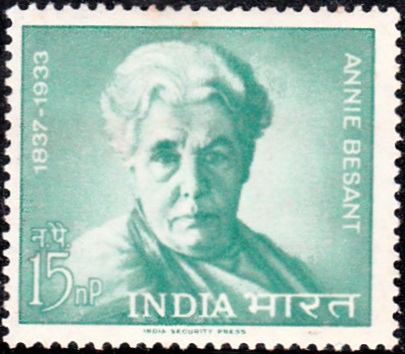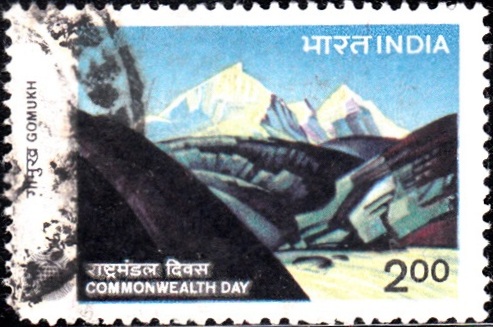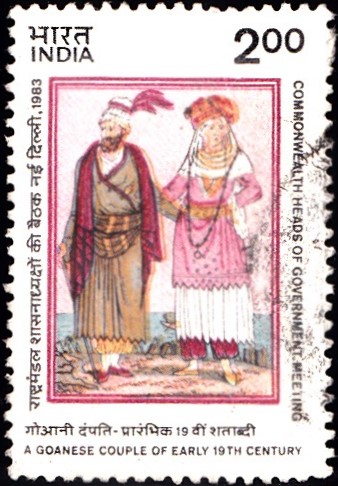
Dr. Annie Besant
A commemorative postage stamp on Annie Besant, 33rd President of Indian National Congress (INC) in 1917 :
Issued on Oct 1, 1963 (Tuesday)
Issued for : The Indian Posts and Telegraphs Department has great pleasure in bringing out a special stamp to honour this great lady. [The Stamp is wrongly dated, gives birth date as 1837 instead of 1847.]
Type : Stamp, Mint Condition
Colour : Blue Green
Denomination : 15 Naye Paise
Size : 3.3 cms x 2.9 cms
Perforation : 13½ x 14
Watermark : All over multiple ‘Lion Capital of Asoka’
Number Printed : 2.5 million
Set : 42 stamps per issue sheet
Printing process : Photogravure
Designed and printed at : India Security Press
Name : Annie Wood
Born on Oct 1, 1847 at Clapham, London, United Kingdom
Died on Sep 20, 1933 at Adyar, Madras Presidency, British India [now in Karnataka, India]
About :
- As one looks back to the decades of India‘s long struggle for freedom, few names stand out with greater glory of distinction than Dr. Annie Besant‘s. For forty years, from 1893 when she first landed in India until the moment of her death in 1933, she laboured for India‘s advancement in every sphere of activity – educational, social, religious and political – with single-minded devotion and rare dedication.
- She was gifted with a prodigious intellect, tremendous organisational capacity, a courage of conviction which defied every penalty and obstacle, and a warm and generous heart. All these were placed without stint or hesitation at India‘s disposal.
- For the first twenty years of her life in India, from 1893 to the commencement of the First World War, Mrs. Besant devoted all her energies and resources to the building up of the Central Hindu College at Varanasi, which later became the foundation on which Pandit Madan Mohan Malaviya reared the Varanasi Hindu University. In collaboration with the distinguished Indian Philosopher, Dr. Bhagvan Das, she translated the Bhagvad-Gita into English, so as to make this priceless treasure accessible to millions who did not know Sanskrit. During this part of her Indian career, Mrs. Besant did her best to revive respect for the ancient teachings of Hinduism and the other great faiths which have their votaries in this country.
- Mrs. Besant was not content with merely proclaimed the goal of home rule for India as a unit in the British Commonwealth. At the end of the first world war, she declared in London before a Parliamentary Committee that India could not accept for all time a Constitution framed for her by the British Government in London. She proceeded, with the warm support of men like Sir Tej Bahadur Sapru and the Rt. Hon’ble V. S. Srinivasa Sastri, to have a Constitution for India as a full-fledged Dominion prepared through a National Convention. The measure, described later as “the Commonwealth of India Bill”, was supported by several leading Indian statesmen.
- Though the Commonwealth of India Bill made no further progress, the seed thus sown was destined to bear fruit at a later stage. India‘s Constituent Assembly, which was brought into being at the end of second world war in 1946, perhaps owed its original impulse in some measure to the joint efforts initiated a quarter of a century earlier by Mrs. Besant and Sir Tej Bahadur Sapru.
- Though Mrs. Besant passed away nearly three decades ago, her spirit still presides over many of India‘s institutions. The ideals which she preached during her life-time are now materialising in the world of practical realities. Looking back over the long period of preparation for freedom and its final achievement, one can only marvel at the incredible record of Mrs. Besant‘s services to India spread over a period of forty years.








[…] took active interest in the Home Rule Movement started by Dr. Annie Besant even while he was in college. It was then that he came into contact with Rajaji. Influenced by […]
[…] and soul, into the freedom struggle and organised the Home Rule Movement in collaboration with Dr. Annie Besant. It was at this time that he gave the nation his slogan : SWARAJ IS MY BIRTH-RIGHT AND I WILL HAVE […]
[…] Vivekananda at Chicago was described by Annie Besant thus “A striking figure, clad in yellow and orange, shining like the Sun of India.“ […]
[…] Kumaraswamy Raja (1898-1957) was born at Rajapalayam in Tamil Nadu. The lives and writings of Annie Besant and Satyamurthy had great influence on his mind and character in his formative years. It was in […]
[…] leaders as Mahatma Gandhi, Motilal Nehru, Lala Lajpat Rai, Swami Shraddhanand, Ali Brothers, Annie Besant and many others. He emerged to be a symbol of Hindu-Muslim unity. His involvement in the […]
[…] The most notable traits of Shri Krishna Menon‘s character were shaped by his parents. Among those outside his family circle who profoundly influenced Krishna Menon were professor Harold Laski, Jawaharlal Nehru and Mrs. Annie Besant. […]
[…] He had a stint as a Lecturer at the Gujarat Vidyapith during 1922-23. Coming under the influence of Dr. Annie Besant, Sri Aurobindo, Rabindranath Tagore, Mahatma Gandhi and Marepalli Ramachandra Sastry (a freedom […]
[…] in the wake of the first World War, which culminated in, among other things, the internment of Mrs. Annie Besant. Of the Home Rule League which she founded Motilal Nehru became a distinguished member. But, soon […]
[…] modern education was yet to reach the women of India, especially the north India. In March 1904, Annie Besant, in a pamphlet entitled ‘The Education of Indian Girls‘, inspired the Indraprastha […]
[…] Mrs. Annie Besant an ardent supporter of Indian self-rule and founder of ‘Indian Home Rule Movement’ called Dayanand Saraswati as the first to raise the slogan, India for Indians. Mahatma Gandhi appreciated his unequivocal pronouncement against untouchability. […]
[…] at a formal function in the Gokhale Hall in George Town, Madras City, on June 17, 1918, by Dr. Annie Besant. The first Hindi class was conducted by Devdas Gandhi. The Sabha was registered as an autonomous […]
[…] Dr. Annie Besant took the child and his brother Nitya under her protection maintaining that Krishnamurti’s body was to be the vehicle for Lord Maitreya, the World Teacher to be. As a boy, Krishnamurti had the supreme beauty of a forest fawn. The face was oval. The large, wide, open eyes gazed into vast distances. There was in him a gravity and supreme dignity. […]
[…] and philosophy, was of absorbing interest to him. For a time he came under the influence of Dr. Annie Besant in collaboration with whom he founded the Central Hindu College. This institution developed in […]